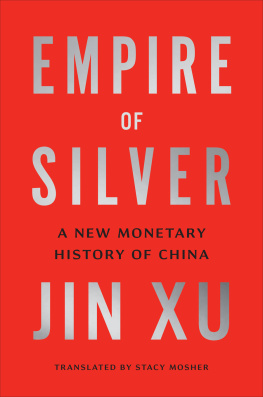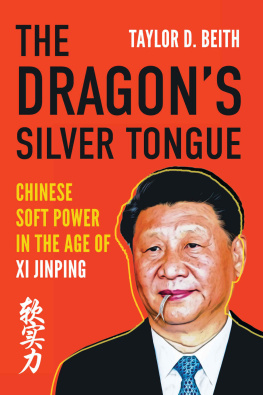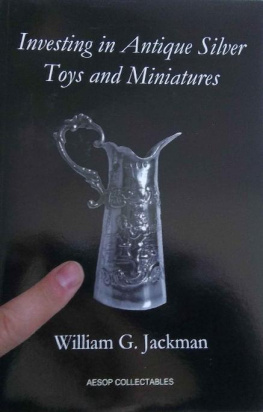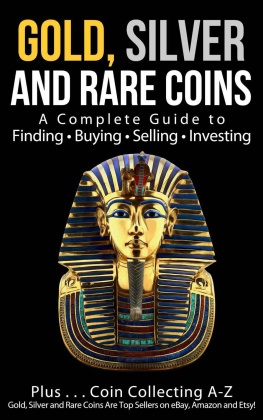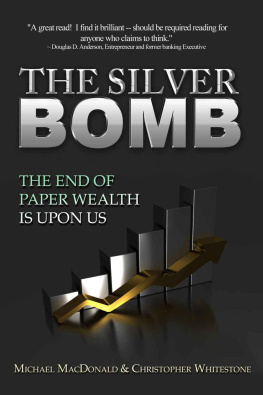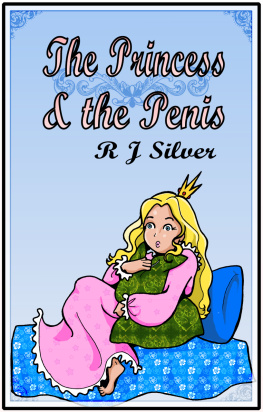Empire of Silver

Copyright 2017 by Jin Xu.
English edition copyright 2021 by Yale University, by arrangement with CITIC Press Corporation.
All rights reserved
This book may not be reproduced, in whole or in part, including illustrations, in any form (beyond that copying permitted by Sections 107 and 108 of the U.S. Copyright Law and except by reviewers for the public press), without written permission from the publishers.
Yale University Press books may be purchased in quantity for educational, business, or promotional use. For information, please e-mail (U.K. office).
Set in Minion type by IDS Infotech Ltd.
Printed in the United States of America.
Library of Congress Control Number: 2020942590
ISBN 978-0-300-25004-6 (hardcover : alk. paper)
A catalogue record for this book is available from the British Library.
This paper meets the requirements of ANSI/NISO Z39.481992 (Permanence of Paper).
10 9 8 7 6 5 4 3 2 1
Money is people.
Ancient Greek proverb
Money has no smell.
English proverb
There is no subtler, no surer means of overturning the existing basis of society than to debauch the currency. The process engages all the hidden forces of economic law on the side of destruction, and it does it in a manner which not one man in a million is able to diagnose.
Macroeconomist John Maynard Keynes (18831946)
Monetary history is part of history in general, and one aim of studying it is to aid the understanding of history in general.
Chinese monetary historian Peng Xinwei (19081967)
I knew where I was going from the day I decided to become an economist. I set out to understand what made economies rich or poor because I viewed that objective as being the essential prerequisite to improving their performance ... My objective as a graduate student was to find out what made economies work the way they did or fail to work. Economic history appeared to be the best field for that objective.
Douglass C. North (19202015), 1993 Nobel Laureate in economics
Contents
Empire of Silver
Introduction
The Curse of Silver
How much better to acquire wisdom rather than gold, and to acquire understanding is more desirable than silver.
The Holy Bible, Proverbs 16:16
The nations with which economic historians are chiefly concerned organize their economic activities under the form of making and spending money ... Cannot economic history be organized most effectively around the evolution of pecuniary institutions?
American economist Wesley C. Mitchell (18741948)
S ilver, i.e. white gold. So says the second-century Chinese dictionary An Explication of Written Characters. Silver is a precious metal, second only to gold in value.
While the West is obsessed with gold, Chinese seem to have always been preoccupied with silver. Throughout Chinese history, from ancient times to the present, the love of silver seems to have deepened over time, and the arduous process of silver becoming Chinas base currency conceals the secret threads of Chinas momentous historical Silvers course from not currency to monetization as legal tender has not been without complications.
During Chinas Warring States, Qin, and Han periods, gold and bronze cash were most widely used. The Six Dynasties (222589) and Sui and Tang dynasties used both bronze coins and silk. During the Song, Jin, Yuan, and early Ming dynasties, paper currency called cash notes (qianchao) circulated. Only from the Five Dynasties onward did silver gradually become a medium of payment. From the Northern and Southern Song dynasties onward, silver came into common use along with bronze cash, and it was officially monetized in China in the mid- and late Ming dynasty. Over the next 500 years, up until the 1830s, China retained silver as its currency through wars large and small and countless catastrophes, with both tael silver and silver dollars in common use.
Compared with the monetary history of the West, Chinas monetary system displayed different characteristics from the outset. In ancient times, the West had a multitude of small kingdoms and international trade flourished. Although a king could designate a currency and its worth within his country, these stipulations could not be applied in the domains of other countries. From earliest times, coins minted from precious metal were locked in as acceptable materials of commerce in the international market. As early as the seventh century b.c.e., the kingdom of Lydia in Asia Minor began minting coins from an alloy of gold and silver (electrum) with set weights and denominated value (China did not begin minting silver coins until the last years of the Qing dynasty). This paved the way for the predominance of precious metal coins in the monetary history of the West.
In comparison, for most of the time before the mid-Ming dynasty, various base-metal coins (bronze, iron) constituted the main forms of Chinese currency, interspersed with some precocious legends of monetary history such as Chinas ultimately failed experiment with paper currency, which lasted more than 400 years, from the Northern Song to the early Ming dynasties. Looking back at Chinas monetary history, the overlap of inflation and deflation frequently lured the government into large-scale plunder of private wealth by issuing large-denomination currencies with no reserve value, or by minting inferior coins. Defying draconian laws and harsh bans, ordinary citizens fought back by boycotting bad money and privately minting currency. At the end of the day, even if the emperor was willing and needed to accept market testing, the fate of Chinas various currenciesfrom the bronze half-ouncer (banliang) and five-grainer (wuzhu) coins to the Kaiyuan coins and on to the Song dynastys bronze and iron coins and paper currencywas basically inseparable from the rise and fall of dynasties.
Even after silver was monetized from the mid-Ming onward, silver was used as a metage (weighted) currency in China, and not in the minted form that had long been customary in the West. Before the Sui and Tang dynasties, tael (liang) silver in the form of ingots (yinting or yinding), silver cakes (yinbing), or tablets (yinhu) can be traced back to the Han dynasty. Ancient ingots (ting) were interchangeable with sycee (ding), and beginning with the Song dynasty they were typically called silver ingots or silver sycee, while sycee began being called yuanbao in the Yuan dynasty. It is said that in the third year of the Yuan dynasty (1266), the term yuanbao, meaning Yuan dynasty treasure, In numismatic terms, this development made the currency more attractive, but in practical use it was an inconvenient and a retrograde step. As for the silver dollar, before China minted its own silver dollars (yuan), silver dollars predominantly came from overseas and were called foreign (waiyang) dollars.
Silver as a metage currency required not only inspection of its purity and quality, but also a multitude of exchange methods in different places, making it inconvenient to use. It was not until the Republican era that the silver dollar officially replaced the silver tael, and silver was able to circulate as Chinas standard currency. Furthermore, although Chinas monetary history has included a number of financial organs such as pawnshops, silver shops, and local private banks, it took a long time for China to develop a modern banking system. This was a major impediment to the expansion of Chinas credit system, and even to its transformation into a modern state.
Next page
